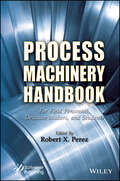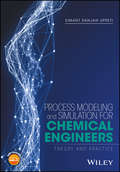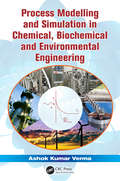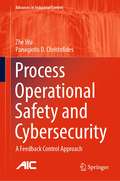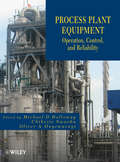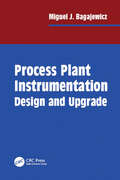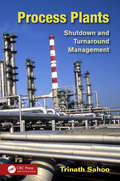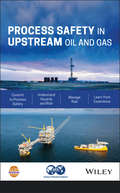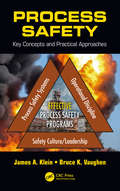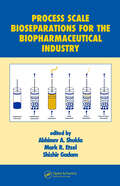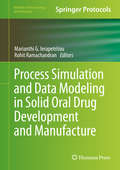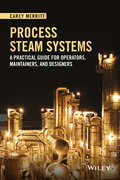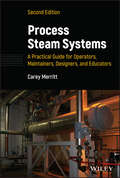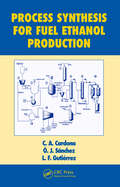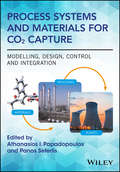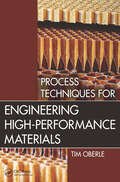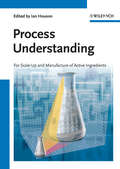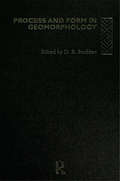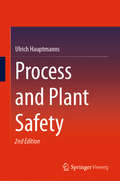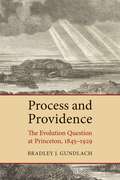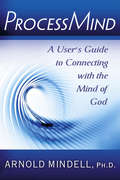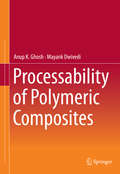- Table View
- List View
Process Machinery Handbook: For Field Personnel, Decision Makers, and Students
by Robert X. PerezProcess Machinery Handbook: For Field Personnel, Decision Makers, and Students equips newcomers and seasoned professionals with essential insights into the diverse world of process machinery, empowering them to understand unique performance characteristics, common failure modes, and effective strategies for enhancing reliability in their operations. Any professional working at a production site for any length of time knows that process machinery comes in a wide range of designs and sizes, but not all process machines are considered equal. Some machines are more critical to the process than others, some are small, some are very large, some spin fast, and some turn relatively slowly. The great diversity in their construction and application can be daunting to those new to the industry and sometimes even challenge machinery veterans. There are many common concepts that apply to all equipment types, but each equipment category has its own unique application and performance characteristics, including cavitation in liquid handling pumps, surging in centrifugal gas compressors, rotor instability in high-speed centrifugal compressors, and the effect of the compression ratio on a reciprocating compressor’s the discharge temperature. It is also essential for users to understand how and why different types of machinery fail, keeping in mind that the common failure modes differ greatly between rotating machinery types. We know that by addressing the common types of failure modes associated with each machine type, we can achieve significant improvements in their reliability. The first step in organizing an effective machinery reliability program is committing to performing failure analyses and gathering failure statistics. These activities will help users learn how and why their machines are failing. The next step is to continuously modify machines, processes, and methods to avoid common failures. Process Machinery Handbook: For Field Personnel, Decision Makers, and Students gives students and professionals alike the tools they need to understand the fundamentals of working with rotating machinery.
Process Modeling and Simulation for Chemical Engineers: Theory and Practice
by Simant R. UpretiThis book provides a rigorous treatment of the fundamental concepts and techniques involved in process modeling and simulation. The book allows the reader to: (i) Get a solid grasp of “under-the-hood” mathematical results (ii) Develop models of sophisticated processes (iii) Transform models to different geometries and domains as appropriate (iv) Utilize various model simplification techniques (v) Learn simple and effective computational methods for model simulation (vi) Intensify the effectiveness of their research Modeling and Simulation for Chemical Engineers: Theory and Practice begins with an introduction to the terminology of process modeling and simulation. Chapters 2 and 3 cover fundamental and constitutive relations, while Chapter 4 on model formulation builds on these relations. Chapters 5 and 6 introduce the advanced techniques of model transformation and simplification. Chapter 7 deals with model simulation, and the final chapter reviews important mathematical concepts. Presented in a methodical, systematic way, this book is suitable as a self-study guide or as a graduate reference, and includes examples, schematics and diagrams to enrich understanding. End of chapter problems (with solutions and computer software available online) are designed to further stimulate readers to apply the newly-learned concepts. End of chapter problems (with solutions and computer software available online www.wiley.com/go/upreti/pms_for_chemical_engineers) are designed to further stimulate readers to apply the newly learned concepts.
Process Modelling and Simulation in Chemical, Biochemical and Environmental Engineering
by Ashok Kumar VermaThe use of simulation plays a vital part in developing an integrated approach to process design. By helping save time and money before the actual trial of a concept, this practice can assist with troubleshooting, design, control, revamping, and more. Process Modelling and Simulation in Chemical, Biochemical and Environmental Engineering explores ef
Process Operational Safety and Cybersecurity: A Feedback Control Approach (Advances in Industrial Control)
by Panagiotis D. Christofides Zhe WuThis book is focused on the development of rigorous, yet practical, methods for the design of advanced process control systems to improve process operational safety and cybersecurity for a wide range of nonlinear process systems. Process Operational Safety and Cybersecurity develops designs for novel model predictive control systems accounting for operational safety considerations, presents theoretical analysis on recursive feasibility and simultaneous closed-loop stability and safety, and discusses practical considerations including data-driven modeling of nonlinear processes, characterization of closed-loop stability regions and computational efficiency. The text then shifts focus to the design of integrated detection and model predictive control systems which improve process cybersecurity by efficiently detecting and mitigating the impact of intelligent cyber-attacks. The book explores several key areas relating to operational safety and cybersecurity including: machine-learning-based modeling of nonlinear dynamical systems for model predictive control;a framework for detection and resilient control of sensor cyber-attacks for nonlinear systems; insight into theoretical and practical issues associated with the design of control systems for process operational safety and cybersecurity; and a number of numerical simulations of chemical process examples and Aspen simulations of large-scale chemical process networks of industrial relevance. A basic knowledge of nonlinear system analysis, Lyapunov stability techniques, dynamic optimization, and machine-learning techniques will help readers to understand the methodologies proposed. The book is a valuable resource for academic researchers and graduate students pursuing research in this area as well as for process control engineers.Advances in Industrial Control reports and encourages the transfer of technology in control engineering. The rapid development of control technology has an impact on all areas of the control discipline. The series offers an opportunity for researchers to present an extended exposition of new work in all aspects of industrial control.
Process Plant Equipment: Operation, Control, and Reliability
by Oliver A. Onyewuenyi Chikezie Nwaoha Michael Holloway“Process Plant Equipment Book is another great publication from Wiley as a reference book for final year students as well as those who will work or are working in chemical production plants and refinery…” -Associate Prof. Dr. Ramli Mat, Deputy Dean (Academic), Faculty of Chemical Engineering, Universiti Teknologi Malaysia “…give[s] readers access to both fundamental information on process plant equipment and to practical ideas, best practices and experiences of highly successful engineers from around the world… The book is illustrated throughout with numerous black & white photos and diagrams and also contains case studies demonstrating how actual process plants have implemented the tools and techniques discussed in the book. An extensive list of references enables readers to explore each individual topic in greater depth…” –Stainless Steel World and Valve World, November 2012 Discover how to optimize process plant equipment, from selection to operation to troubleshooting From energy to pharmaceuticals to food, the world depends on processing plants to manufacture the products that enable people to survive and flourish. With this book as their guide, readers have the information and practical guidelines needed to select, operate, maintain, control, and troubleshoot process plant equipment so that it is efficient, cost-effective, and reliable throughout its lifetime. Following the authors' careful explanations and instructions, readers will find that they are better able to reduce downtime and unscheduled shutdowns, streamline operations, and maximize the service life of processing equipment. Process Plant Equipment: Operation, Control, and Reliability is divided into three sections: Section One: Process Equipment Operations covers such key equipment as valves, pumps, cooling towers, conveyors, and storage tanks Section Two: Process Plant Reliability sets forth a variety of tested and proven tools and methods to assess and ensure the reliability and mechanical integrity of process equipment, including failure analysis, Fitness-for-Service assessment, engineering economics for chemical processes, and process component function and performance criteria Section Three: Process Measurement, Control, and Modeling examines flow meters, process control, and process modeling and simulation Throughout the book, numerous photos and diagrams illustrate the operation and control of key process equipment. There are also case studies demonstrating how actual process plants have implemented the tools and techniques discussed in the book. At the end of each chapter, an extensive list of references enables readers to explore each individual topic in greater depth. In summary, this text offers students, process engineers, and plant managers the expertise and technical support needed to streamline and optimize the operation of process plant equipment, from its initial selection to operations to troubleshooting.
Process Plant Instrumentation: Design and Upgrade
by Miguel J. BagajewiczThis is the first in-depth presentation in book form of current analytical methods for optimal design, selection and evaluation of instrumentation for process plants. The presentation is clear, concise and systematic-providing process engineers with a valuable tool for improving quality, costs, safety, loss prevention, and production accounting.
Process Plants: Shutdown and Turnaround Management
by Trinath SahooWith large amounts of revenue at stake, process industries are focusing more on turnaround management as they strive to lengthen the interval between turnarounds. This book outlines a strategy to execute optimized shutdown and turnaround by changing plant operating conditions and inspection techniques. Because shutdown cost for a petroleum refinery is normally 30 percent higher than annual maintenance costs, this book details how to manage the more favorable turnaround option. The author explores different aspects, including philosophy, planning and scheduling, estimation, contractor management, and execution.
Process Safety Leadership from the Boardroom to the Frontline: Leadership From The Boardroom To The Frontline
by CcpsFor leaders to fulfill their process safety responsibilities, they must demonstrate the same leadership attributes required for success in every other business area. This book discusses how leaders apply these attributes to drive strong process safety cultures and disciplined management systems. Based on benchmarking and broad industrial experience, this groundbreaking book begins by making the “Business Case for Process Safety,” showing the many ways process safety benefits the organization. It then describes essential behaviors and actions for leaders to drive excellence in process safety. Key topics include: Demonstrating process safety leadership; Maintaining management system accountability; Driving culture; Establishing risk criteria and safeguards; Driving operation within constraints; Addressing accidents and near-misses; Ensuring corporate memory; Verifying execution
Process Safety for Engineers: An Introduction
by CCPS (Center for Chemical Process Safety)Process Safety for Engineers Familiarizes an engineer new to process safety with the concept of process safety management In this significantly revised second edition of Process Safety for Engineers: An Introduction, CCPS delivers a comprehensive book showing how Process Safety concepts are used to reduce operational risks. Students, new engineers, and others new to process safety will benefit from this book. In this updated edition, each chapter begins with a detailed incident case study, provides steps that help address issues, and contains problem sets which can be assigned to students. The second edition covers: Process Safety: including an overview of CCPS’ Risk Based Process Safety Hazards: specifically fire and explosion, reactive chemical, and toxicity Design considerations for hazard control: including Hazard Identification and Risk Analysis Management of operational risk: including management of change In addition, the book presents how Process Safety performance is monitored and sustained. The associated online resources are linked to the latest online CCPS resources and lectures.
Process Safety in Upstream Oil and Gas
by CCPS (Center for Chemical Process Safety)The book makes the case for process safety and provides a brief overviews of the upstream industry and of CCPS Risk Based Process Safety. The majority of the book focuses on the concepts of implementing process safety in wells, onshore, offshore, and projects. Topics include Overview of Upstream Operations; Overview of Risk Based Process Safety (RBPS); Application of RBPS in Drilling, Completions, Work-Overs & Interventions, Application of RBPS in Onshore Production, Application of RBPS in Offshore Production, Application of RBPS to Engineering Design, Installation, and Construction, Future Developments in the Field
Process Safety: Key Concepts and Practical Approaches
by James A. Klein Bruce K. VaughenEffective process safety programs consist of three interrelated foundations—safety culture and leadership, process safety systems, and operational discipline—designed to prevent serious injuries and incidents resulting from toxic releases, fires, explosions, and uncontrolled reactions. Each of these foundations is important and one missing element can cause poor process safety performance. Process Safety: Key Concepts and Practical Approaches takes a systemic approach to the traditional process safety elements that have been identified for effective process safety programs. More effective process safety risk reduction efforts are achieved when these process safety systems, based on desired activities and results rather than by specific elements, are integrated and organized in a systems framework. This book provides key concepts, practical approaches, and tools for establishing and maintaining effective process safety programs to successfully identify, evaluate, and manage process hazards. It introduces process safety systems in a way that helps readers understand the purpose, design, and everyday use of overall process safety system requirements. Understanding what the systems are intended to achieve, understanding why they have been designed and implemented in a specific way, and understanding how they should function day-to-day is essential to ensure continued safe and reliable operations.
Process Scale Bioseparations for the Biopharmaceutical Industry (Biotechnology and Bioprocessing)
by Abhinav A. ShuklaThe biopharmaceutical industry has become an increasingly important player in the global economy, and the success of these products depends on the development and implementation of cost-effective, robust and scaleable production processes. Bioseparations-also called downstream processing- can be a key source of competitive advantageto biopharmaceut
Process Simulation and Data Modeling in Solid Oral Drug Development and Manufacture (Methods in Pharmacology and Toxicology)
by Marianthi G. Ierapetritou Rohit RamachandranThis thorough volume aims to provide pharmaceutical engineers with an introduction to the current state of the art in modeling and simulation of pharmaceutical processes and to summarize a number of practical applications of relevant methodologies in drug product development. Chapters include explorations of simulation and modeling methodologies, data collection and analysis, development of novel sensing techniques, development and integration of individual unit models, optimization approaches for data-based models, design space evaluation techniques, informatics-based methodologies, and emerging topics in pharmaceutical process development. As a part of the Methods in Pharmacology and Toxicology series, the chapters contain the kind of detail and implementation advice that will make the transition into the laboratory as smooth as possible. Authoritative and cutting edge, Process Simulation and Data Modeling in Solid Oral Drug Development and Manufacture seeks to promote research into process systems methodologies and their application in pharmaceutical product and process development, which will undoubtedly become an increasingly important area in the future.
Process Steam Systems
by Carey MerrittComprehensively describes the equipment used in process steam systems, good operational and maintenance practices, and techniques used to troubleshoot system problems Explains how an entire steam system should be properly designed, operated and maintained Includes chapters on commissioning and troubleshooting various process systems and problems Presents basic thermodynamics and heat transfer principles as they apply to good process steam system design Covers Steam System Efficiency Upgrades; useful for operations and maintenance personnel responsible for modifying their systems sioning and Troubleshooting the Water Treatment Equipment
Process Steam Systems: A Practical Guide for Operators, Maintainers, Designers, and Educators
by Carey MerrittProcess Steam Systems A comprehensive and accessible handbook for process steam systems The revised second edition of Process Steam Systems: A Practical Guide for Operators, Maintainers, Designers, and Educators delivers a practical guide to ensuring steam systems are properly and efficiently designed, operated, and maintained. The book provides comprehensive information designed to improve process steam system knowledge, reliability, and integration into current manufacturing processes. The most up-to-date version of this volume includes brand-new coverage of current codes, sustainability measures, and updated applications. Heat transfer theory and thermodynamics are tied into practical applications with new practice problems ideal for both professionals seeking to improve their skills and engineers-in training. Readers will also find: Thorough design criteria for process steam systems, complete with detailed illustrations for piping and controls An entirely new chapter on the history of steam systems, including the evolution of the ASME code and boiler accidents Revised coverage of current NFPA, ASME, CSD-1, FM, and building codes, as well as new insurance requirements relevant to practitioners in the industry Expansive design guidance for steam system efficiency upgrades Perfect for operations and maintenance staff at manufacturing, healthcare, and commercial laundries, Process Steam Systems: A Practical Guide for Operators, Maintainers, Designers, and Educators will also earn a place in the libraries of consulting engineers and engineering students with an interest in process manufacturing.
Process Synthesis for Fuel Ethanol Production (Biotechnology and Bioprocessing)
by C.A. Cardona O.J. Sanchez L.F. GutierrezThis book is a comprehensive guide to the design and analysis of the most advanced technologies for fuel ethanol production from feedstocks. It describes how process systems engineering can be applied to fuel ethanol production to achieve new levels of efficiency according to technical, economic, and environmental criteria. The authors cover liquid biofuels; various types of feedstocks, including sugars, starchy crops, lignocellulosic biomass, and microorganisms; and hydrolysis technologies, such as saccharification. They also address new technological innovations based on process integration to reduce energy consumption and the environmental issues of bioethanol production.
Process Systems and Materials for CO2 Capture: Modelling, Design, Control and Integration
by Athanasios I. Papadopoulos Panos SeferlisThis comprehensive volume brings together an extensive collection of systematic computer-aided tools and methods developed in recent years for CO2 capture applications, and presents a structured and organized account of works from internationally acknowledged scientists and engineers, through: Modeling of materials and processes based on chemical and physical principles Design of materials and processes based on systematic optimization methods Utilization of advanced control and integration methods in process and plant-wide operations The tools and methods described are illustrated through case studies on materials such as solvents, adsorbents, and membranes, and on processes such as absorption / desorption, pressure and vacuum swing adsorption, membranes, oxycombustion, solid looping, etc. Process Systems and Materials for CO2 Capture: Modelling, Design, Control and Integration should become the essential introductory resource for researchers and industrial practitioners in the field of CO2 capture technology who wish to explore developments in computer-aided tools and methods. In addition, it aims to introduce CO2 capture technologies to process systems engineers working in the development of general computational tools and methods by highlighting opportunities for new developments to address the needs and challenges in CO2 capture technologies.
Process Techniques for Engineering High-Performance Materials
by Tim OberleMost processed materials retain a memory of their production process at the molecular level. Subtle changes in production-such as variations in temperature or the presence of impurities-can impart performance benefits or drawbacks to individual batches of products. Some product developers have taken advantage of this process dependency to tailor pr
Process Understanding: For Scale-Up and Manufacture of Active Ingredients
by Ian HousonProcess Understanding is the underpinning knowledge that allows the manufacture of chemical entities to be carried out routinely, robustly and to the required standard of quality. This area has gained in importance over the last few years, particularly due to the recent impetus from the USA`s Food and Drug Administration. This book covers the multidisciplinary aspects required for successful process design, safety, modeling, scale-up, PAT, pilot plant implementation, plant design as well the rapidly expanding area of outsourcing. In discussing what process understanding means to different disciplines and sectors throughout a product`s life cycle, this handbook and ready reference reveals the factors important to the development and manufacture of chemicals. The book focuses on the fundamental scientific understanding necessary. for a smoother technical transfer between the disciplines, leading to more effective and effi cient process development and manufacturing. A range of case studies are used to exemplify and illustrate the main issues raised. As a result, readers will appreciate that process understanding can deliver a real competitive advantage within the pharmaceuticals and fine chemicals industry. This book serves as an aid to meeting the stringent regulations required by the relevant authorities through demonstrable understanding of the underlying science.
Process Validation in Manufacturing of Biopharmaceuticals (Biotechnology and Bioprocessing)
by Hal Baseman Scott Rudge Anurag Singh RathoreThe fourth edition of Process Validation in Manufacturing of Biopharmaceuticals is a practical and comprehensive resource illustrating the different approaches for successful validation of biopharmaceutical processes. A pivotal text in its field, this new edition provides guidelines and current practices, contains industrial case studies, and is expanded to include in-depth analysis of the new Process Validation (PV) guidance from the US FDA. Key Features: Offers readers a thorough understanding of the key concepts that form the basis of a good process validation program for biopharmaceuticals. Includes case studies from the various industry leaders that demonstrate application of these concepts. Discusses the use of modern tools such as multivariate analysis for facilitating a process validation exercise. Covers process characterization techniques for scaling down unit operations in biopharmaceutical manufacturing, including chromatography, chemical modification reactions, ultrafiltration, and microfiltration, and practical methods to test raw materials and in-process samples. Providing a thorough understanding of the key concepts that form the basis of a good process validation program, this book will help readers ensure that PV is carried out and exceeds expectations. Fully illustrated, this is a much-needed practical guide for biopharmaceutical manufacturers.
Process and Form in Geomorphology
by David StoddartProcess and Form in Geomorphology marks a turning point in geomorphological research. Stoddart has brought together a team of the leading international experts to offer important new studies into the processes, theory and history of landforms, and to present a framework for taking research forward into the new millenium. Illustrated throughout, Process and Form in Geomorphology takes up the challenges of the research agenda set by Richard Chorley and offers fresh insights into his unique contribution.
Process and Plant Safety
by Ulrich HauptmannsAccidents in industrial installations are random events. Hence they cannot be totally avoided. Only the probability of their occurrence may be reduced and their consequences be mitigated. The book proceeds from hazards caused by materials and process conditions to indicating engineered and organizational measures for achieving the objectives of reduction and mitigation. Qualitative methods for identifying weaknesses of design and increasing safety as well as models for assessing accident consequences are presented. The quantitative assessment of the effectiveness of safety measures is explained. The treatment of uncertainties plays a role there. They stem from the random character of the accident and from lacks of knowledge of some of the phenomena to be addressed. The reader is acquainted with the simulation of accidents, with safety and risk analyses and learns how to judge the potential and limitations of mathematical modelling. Risk analysis is applied amongst others to “functional safety” and the determination of “appropriate distances” between industry and residential areas (land-use planning). This shows how it can be used as a basis for safety-relevant decisions. Numerous worked-out examples and case studies addressing real plants and situations deepen the understanding of the subjects treated and support self-study.
Process and Providence: The Evolution Question at Princeton, 1845-1929
by Bradley J. GundlachCharles Hodge, James McCosh, B. B. Warfield -- these leading professors at Princeton College and Seminary in the nineteenth and early twentieth centuries are famous for their orthodox Protestant positions on the doctrine of evolution. In this book Bradley Gundlach explores the surprisingly positive embrace of developmental views by the whole community of thinkers at old Princeton, showing how they embraced the development not only of the cosmos and life-forms but also of Scripture and the history of doctrine, even as they defended their historic Christian creed.Decrying an intellectual world gone “evolution-mad,” the old Princetonians nevertheless welcomed evolution “properly limited and explained.” Rejecting historicism and Darwinism, they affirmed developmentalism and certain non-Darwinian evolutionary theories, finding process over time through the agency of second causes — God’s providential rule in the world -- both enlightening and polemically useful. They also took care to identify the pernicious causes and effects of antisupernatural evolutionisms. By the 1920s their nuanced distinctions, together with their advocacy of both biblical inerrancy and modern science, were overwhelmed by the brewing fundamentalist controversy.From the first American review of the pre-Darwinian Vestiges of the Natural History of Creation to the Scopes Trial and the forced reorganization of Princeton Seminary in 1929, Process and Providence reliably portrays the preeminent conservative Protestants in America as they defined, contested, and answered -- precisely and incisively -- the many facets of the evolution question.
ProcessMind
by Arnold MindellEinstein said, "I want to know the mind of God, the rest are details." This book is therapist Arnold Mindell's response. By processmind he means an earth-based experience of the universal state of consciousness that, he argues, pervades all reality. It is perhaps our most basic, least known, and greatest power, combining the nonlocality of modern physics with altered states of consciousness found in peak experiences. What makes this book unique is that it offers some experience of this mind-state to the reader. Mindell does so by connecting cosmic patterns seen in physics with experiences occurring in psychology and world spiritual traditions. He draws together ideas about Aboriginal totem spirits, quantum entanglement, and nonlocality to describe the "structure of God experiences." Enhancing his clear presentation are around 80 illustrations and 30 experiential exercises based on tested approaches that actualize our deepest, unitive consciousness. Through rational thinking and earth-based, inner experience, the reader can sense how the processmind's self-organizing intelligence helps with dreams, body symptoms, relationships, and large-group conflict issues. Altogether, the book is a kind of user's guide to tapping into an immense power that can benefit our own individual life and, ultimately, the world.
Processability of Polymeric Composites
by Anup K. Ghosh Mayank DwivediThis textbook covers the processing of advanced composites and their various technologies, with special emphasis on the distinct characteristics of processability. The book covers the impact of different processing techniques on the performance and characteristics of the final product. Written with a didactic approach, the volume contains extensive illustrations and pedagogic features (including examples and exercises) to help the reader assess and correlate existing technologies. The book will be useful as a text in graduate courses in processing of polymers and composites and can additionally be used as a professional reference.
